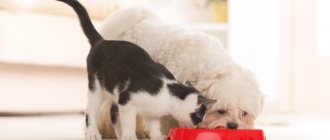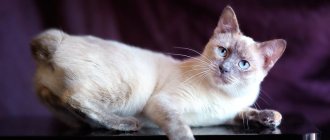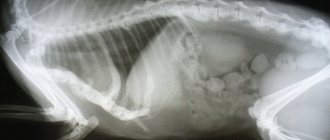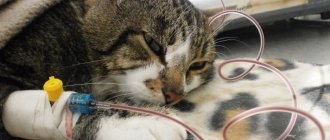Causes
Diseases of the upper respiratory tract are most often associated with anomalies in the development of the oropharyngeal cavity, defects in the development of the skull in various breeds, trauma, neoplasms and infections.
The lower respiratory tract is characterized by viral or bacterial infection. Another cause of breathing disorders can be the entry of foreign bodies, cysts and tumors, as well as gas poisoning.
For chest diseases, they arise as complications of inflammatory lung diseases, traumatic injury and developmental abnormalities.
Pathologies associated with breathing problems
If a cat breathes from its sides and stomach, it means it does not have enough oxygen. For some reason, not enough air gets into the lungs, the body begins to “panic” and tries to make up for the deficiency. The animal breathes deeply and frequently. Trying to take in more air.
In medicine, this phenomenon is usually called abdominal breathing. It can be one of the symptoms of various diseases. The most common .
- Damage to the oral mucosa . If a cat has ulcers, fistulas, etc. in its mouth, it may simply be painful for the animal to breathe. This process ceases to be natural. It brings discomfort, and the body tends to “breathe for future use,” swallowing more air at a time. However, this doesn't help. Breathing becomes difficult, and its frequency, on the contrary, increases.
- Infectious and inflammatory diseases of the respiratory system . This could be rhinitis, tracheitis, bronchitis, pneumonia or a banal acute respiratory infection, which is typical not only for people, but also for cats. When fighting an infection, the immune system secretes mucus containing large numbers of white blood cells. This is completely normal, but the airways become clogged and it is difficult for air to get to the lungs. Experiencing its deficiency, the cat breathes deeply and frequently from its belly. Associated symptoms of infectious-inflammatory diseases include cough, nasal discharge, bad breath, and increased body temperature.
- Laryngitis, bronchial asthma, allergies . Shallow breathing is often observed with them. It is accompanied by a dry paroxysmal cough. If there is an advanced form of asthma, the cat may suffocate.
- Tumors and hernias in the respiratory tract . Any neoplasms in the larynx, trachea, or lungs are a serious obstacle to air. Naturally, the cat feels the lack of it, breathes heavily and frequently, and its stomach heaves. If the situation does not last a day, not two, or even a week, chronic hypoxia develops. The body, which constantly lacks oxygen, weakens, systems begin to malfunction, and additional diseases are triggered. A cat suffering from cancer or having a hernia can be easily distinguished from a healthy animal. She not only breathes heavily from her stomach, but is also apathetic, eats poorly, and is clearly underweight.
- Rib fractures . With such injuries, the lungs are pinched by shrapnel and cannot function normally. Therefore, the cat breathes frequently, and its stomach shakes. A fracture can be suspected if the pet reacts inadequately to touch, which is explained by pain. A cat can take unnatural positions, sleep constantly on only one side, etc.
- Cardiovascular diseases . Also one of the fairly common reasons. Especially in certain breeds of cats (British, Maine Coon), which have a genetic predisposition to heart pathologies. In addition to the fact that the cat breathes frequently and deeply with such dysfunctions, there are other symptoms. Among them are wheezing in the chest, cyanosis of the oral mucosa, pallor of the skin, and lethargy of the animal. During a severe attack, breathing may stop, and then the cat needs emergency help.
- Foreign body in the respiratory tract . Situations where a cat chokes on a bone or hard piece of food are very common. In most cases, the animals manage to cough and push out the foreign object. However, sometimes it penetrates deep enough and blocks access to air. Because of this, the cat breathes deeply and frequently. In this case, she also needs human help.
It is imperative to find out what caused the deviation. Otherwise, it will be impossible to prescribe adequate treatment. Sometimes there is no time to spend a long time understanding the causes of abnormal breathing, because you need to immediately save the animal.
Digestive system of a cat
The digestive system of cats is the same as that of all mammals. With the help of its organs, food enters the body, is digested, and nutrients are absorbed. First, food enters the mouth, where it is crushed by teeth and powerful jaws. A cat's teeth perform different functions: the fangs serve as a defensive weapon and for catching prey, and small incisors for stripping meat from bones. It is noteworthy that cats do not chew food, but only crack it with sharp molars. Here, in the mouth, the digestion process begins with the help of saliva.
The cat's tongue is involved in the absorption of food and is an object for cleaning the fur, since it is covered with horny scales convenient for this. From the oral cavity, food is directed through the muscular esophagus into the single-chamber stomach. The esophagus has the ability to move food in two directions. This is important for cats because fur, bones and indigestible food particles end up in their stomachs. And vomiting, performing the cat’s self-preservation function, cleanses the stomach.
The digestion process occurs in the stomach under the influence of secretions secreted by its mucous membrane. From the stomach, food passes into the small intestine, where digestion continues with the help of an entire “chemical laboratory”. This includes gastric juice with the enzymes necessary for digestion, and bile (produced in the liver and secreted from the gallbladder through the bile ducts), which helps break down fats. Pancreatic juice is also secreted here, which carries substances that digest all components of food: fats, carbohydrates and proteins. With the help of all these important components, food is prepared for absorption into the blood through the intestinal walls, and the circulatory system delivers the resulting nutrients to all organs.
The length of the small intestine in a cat exceeds the length of the body by 3-4 times and is equal to 1-1.8 m; it is significantly shorter than that of vegetarian mammals (they have an intestinal length of 20-42 m), since the cat is a predator that eats meat.
The large intestine is a continuation of the small intestine. Solid, unprocessed food remains enter it along with gland secretions and bacteria. The large intestine consists of the cecum (2-4 cm), rectum and colon (cats do not have an appendix). The rectum performs an excretory function, forms feces, and maintains conditions for the proliferation of bacteria necessary for the body. The anus is closed thanks to the double sphincter, and feces are retained in the intestines. The intestines are cleansed once or twice a day in small portions.
Pneumonia
Pneumonia is an inflammation of the lungs that occurs as an independent disease or as a complication of other diseases. Based on the nature of the spread of the inflammatory process and the mechanism of its development, lobar and lobular pneumonia are distinguished. According to the nature of the development of the pathological process, lobular pneumonia is divided into bronchopneumonia (catarrhal pneumonia), metastatic, atelectatic, aspiration and hypostatic. Lobar pneumonias include lobar and infectious pneumonias. According to the nature of the clinical course, acute and chronic pneumonia are distinguished.
Bacterial and viral microflora in combination with factors that weaken the body's resistance, such as colds in cats kept in apartments, sudden hypothermia of the animal, frequent bathing, drafts, drinking cold water, feeding frozen meat or fish can be the causes of the disease.
With pneumonia, the cat's condition is depressed, the body temperature is elevated, there is no appetite, a cough appears, breathing becomes difficult and becomes more frequent. There is discharge from the nose, sometimes with an unpleasant odor. In the lobar form of pneumonia, the disease occurs suddenly, the animal is depressed, there is no appetite, body temperature rises by 1–2 °C, breathing is rapid, the mucous membrane of the eyes is hyperemic, and the pulse is rapid.
The diagnosis is made on the basis of clinical and radiological studies.
When the first signs of the disease are detected, a veterinary specialist is immediately called, then the sick pet is placed on a warm bedding, and easily digestible food is introduced into the diet.
Pneumonia is treated with antibiotics or sulfonamides, expectorants, to increase the body's resistance, nonspecific therapy (gamma globulin), cardiac medications are used, and they also prescribe dietary nutrition and wrapping the animal.
Measuring body temperature of dogs and cats
Thermometry is an objective research method that facilitates the diagnosis of diseases.
Body temperature is measured in dogs and cats with a maximum mercury thermometer. Before administration, shake it, holding the mercury reservoir with your index finger, and then lubricate it with oil or Vaseline. The best place to measure body temperature is the rectum, where the thermometer is inserted with a slight rotational movement, then fixing it on the tail using a sponge. During this procedure, animals are held by the head. Measurement time is 8-10 minutes.
Normal body temperature in dogs ranges from 37.5-39.0 °C, and in cats 38-39.5 °C. It should be borne in mind that it depends on age, gender, breed, and external temperature. Puppies, kittens, bitches and cats have a higher temperature than adults and males. Its minimum values are observed in the second half of the night, and its maximum values are recorded in the evening hours.
Pleurisy
Pleurisy
- inflammation of the pleura. There are primary and secondary; one-sided and two-sided; dry and wet (exudate); serous, serous-fibrinous, purulent and putrefactive pleurisy.
Etiology. Primary pleurisy occurs after hypothermia, especially in emaciated, old cats, and also as a complication of pneumothorax, pneumonia, and tuberculosis. The disease is characterized by a certain seasonality: in spring and autumn, in rainy weather pleurisy is more common. Pleurisy also occurs as a result of injury to the animal’s chest (for example, when a cat falls from a height).
With dry pleurisy, fibrin is layered on the pleura, sometimes the visceral and parietal layers of the pleura grow together (adhesive pleurisy). Exudative pleurisy occurs with the accumulation in the pleural cavity of first serous or serous-catarrhal exudate, which can later become purulent and putrefactive. Respiratory and cardiac functions become so difficult that they can cause the death of the cat.
Symptoms of the disease depend on the nature and extent of the lesions. The animal is lethargic, refuses food, the body temperature is elevated, an intermittent fever, shortness of breath, shallow, abdominal breathing are observed; with dry pleurisy - pain in the intercostal spaces; Friction sounds coincide with chest excursions. With effusion pleurisy - splashing noises on auscultation. The pulse is small wave, weak filling, the cardiac impulse is weakened, the sounds are muffled, tachysystole (signs of increasing heart failure).
The diagnosis is made on the basis of anamnesis, analysis of a set of symptoms, test puncture and X-ray data. The disease should be differentiated from hydrothorax and pneumonia. The course of the disease depends on the form and severity of the process. With proper treatment and care, pleurisy ends with recovery within 2-3 weeks. However, secondary pleurisy can last for months or even years (tuberculosis).
Purulent and putrefactive pleurisy often ends in death during the first decade of the disease with symptoms of hyperthermia and the depressed state of the animal.
Treatment must be comprehensive. They create a proper hygienic regime, ensure rest, and prescribe an easily digestible diet. For pleurisy, multivitamins, antibiotics, and sulfonamides are also indicated; UV irradiation, UHF therapy, Sollux. Diuretics, salicylates, and iodides are used. For purulent-putrefactive pleurisy, a puncture is made into the pleural cavity, the contents are sucked out and solutions of antiseptics (antibiotics, norsulfazole, ethacridine, etc.) are injected. Prevention of disease consists of preventing parasitic and infectious diseases, injuries, providing comfortable conditions for keeping the animal (excluding hypothermia, drafts, etc.).
Emphysema
Emphysema is an abnormal increase in lung volume. It occurs as a consequence of the expansion of the alveoli after various pathological processes or as a result of lung injury with the penetration of air into the interalveolar and interlobular tissue.
But although the dilated alveoli contain more air, they practically do not participate in breathing, because their functions are impaired, therefore, with increased pulmonary volume, the respiratory surface decreases, which is compensated by more frequent breathing and increased work of the cardiovascular system. Respiratory failure develops and progresses over time, especially if left untreated. In case of lung injury, emphysema and respiratory failure develop rapidly, requiring immediate resuscitation measures, in the absence of which the animal dies.
The clinical picture depends on the degree of lung damage. Shortness of breath is observed - exhalation is prolonged and difficult. The chest increases in size and becomes barrel-shaped. When you inhale, the intercostal spaces are strongly retracted, and when you exhale, they protrude.
Treatment depends on the course of the disease: acute or chronic. Chronic emphysema is incurable and its treatment is symptomatic during periods of exacerbation with physiotherapy. Treatment of acute emphysema is aimed at restoring the functions of the alveoli with the prescription of antihistamines, cardiotonics and bronchodilators. Physical activity is completely avoided, vitamins are prescribed and bronchitis is treated, which often complicates emphysema.
Cats eyes
The love for night hunting in cats is caused by the peculiarities of the sensory organs and the structure of the eyes. The special arrangement of the eyes provides a field of view of 185 degrees. Both eyes look in the same direction, which makes vision three-dimensional, like in humans. And hunting at night is facilitated by the presence of a layer of reflective cells located behind the retina. The light is reflected from this shiny fabric and again enters the light perception zone.
The result is vision that is several times sharper than humans, although cats cannot see in complete darkness either. Under favorable circumstances, we can see the reflected light in the eyes of a cat at a distance of 80 m. We cannot compete with a cat in “night vision”.
It is believed that a cat can distinguish colors, but with less brightness and contrast.
A cat's pupil is special, formed by the iris, the name of which is of Greek origin - “ iris ”. The muscle fibers of the iris make it mobile, and it actively reacts to light. This ability is explained by its structure, which uses the principle of an automatic diaphragm; it transmits the required amount of light to the hypersensitive retina.
We can observe this process by seeing the pupil transform into a narrow vertical slit in bright light. With little light, the pupil becomes dark and takes on a round shape. If the cat’s pupils remain round in high light conditions, then we can assume some kind of disease or strong excitement from some external stimulus. Taking certain medications also works.
Cats' dexterity and good spatial orientation are explained by their ability to correctly estimate distances to objects. Cats perceive moving objects best. Being in absolute darkness, although a cat cannot see, it is not as helpless as a human. Acute hearing and touch are included in the work and help it.
Whiskers are also irreplaceable in such cases ; a cat has about twelve pairs of them. When a cat moves in the dark, the resulting air waves are reflected from objects. And with its whiskers, the cat senses the slightest vibrations in the air and does not bump into obstacles.
A cat's eyes have additional protection: a nictitating membrane. This so-called third eyelid protects the surface of the cornea from dust. It is almost invisible, it is hidden in the nasal corner of the eye, but it can stretch over the entire eye. And if the cat is sick, it may fall out. The color of the eyes depends on the intensity of the coloring substance - the pigment that colors the “iris”. It can be golden, greenish, blue, and in albinos - red, since they lack pigment and small vessels filled with blood give the eyes a red color.
General preventive recommendations
Since there can be many causes of respiratory problems in cats, preventive measures boil down to maintaining the good physical condition of the animal. If the body has high resistance, the cat gets sick much less often and becomes more resilient. In addition, the cat is less likely to develop any hereditary diseases.
It is necessary to ensure that the animal does not overheat in the summer, do not overload it beyond measure, and do not overfeed it. It is very good if, from childhood, the kitten is surrounded by a calm, friendly environment.
Video
Puberty of cats
Many factors can influence a cat's puberty. These include the conditions of detention, the breed, and simply the individual characteristics of each animal. Therefore, the first heat can occur at five months, or maybe at 9-18 months, as, for example, in cats of large, long-haired breeds.
Seasons can also influence the onset of puberty. A cat born in the summer can mature in eight months, while a spring cat can mature in a year or more.
Characteristic signs of maturation in cats are the production of loud uterine sounds and the adoption of poses typical of mating. Cats also become loud at this time, sometimes they mark their territory.
But all these phenomena do not mean the complete physiological development of the cat’s body, and do not indicate its readiness to use it for reproduction. Physiological maturity occurs no earlier than 10-16 months (depending on the breed). It is at this age, after the second or third heat, that the cat can be coated.
Before this time, the cat can be prepared for an important mission and vaccinated. Her body will get stronger and take shape. After the onset of physiological maturity, a cat is able to produce healthy offspring for 5-6 years without compromising its health. And only after this time, with age, her litters will begin to decrease, as will the size of the kittens.
Periods of estrus correspond to cycles of sexual arousal; their duration is 6-8 days. And between heats there can be breaks of one or two weeks, or long ones - up to six months. Vaccinations must be done in advance, but it is not recommended to do this immediately before coating or even two weeks in advance.
We must remember that mating during the first heat can end unfavorably.
Cats, like all living beings, have deviations in physical development in one direction or another. In some breeds, especially eastern ones, signs of puberty appear very early, and regular estrus appears. Long-term non-covering of such cats threatens them with diseases: polycystic disease, exhaustion, disruption of the estrus cycle and hormonal abnormalities.
To avoid such problems, it is necessary to mate the cat, if possible earlier, but be sure to consult a doctor about the cat’s physiological readiness for pregnancy and raising offspring. Conditional recommendations for breeding for the third heat and by the age of one year lose all meaning; here it is worth acting in accordance with the opinion of veterinarians and breed specialists.










